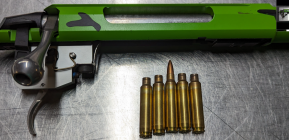This is from the Manson Reamers website:
How Ackley Improved Chambers are Headspaced
“Ackley Improved” versions of standard calibers have been popular for many years. Increased velocity, reduced brass stretch and the desire for something unique are all reasons for customers requesting these chamberings.
Headspacing improved versions of rimmed or belted cases presents little difficulty because headspace is controlled by the rim or belt—in the same manner a standard chamber would be headspaced, using standard headspace gages. Setting correct headspace of improved rimless chambers, however, is more involved because the cartridge is not held by the same contact points as in a standard chamber. Further complicating the headspace issue is the requirement of being able—safely– to fire a factory round in an improved chamber, with the result being a properly fireformed improved case.
Rimless, shouldered cartridges are normally located within a chamber by the breech face—which contacts the base of the cartridge, and the shoulder of the chamber—which contacts the cartridge’s shoulder along its entire length. When fireforming a standard cartridge in an improved chamber, the base of the cartridge contacts the breech face in the usual manner, but the front of the case is contacted only at the neck/shoulder junction and not along the entire length of the shoulder.
Because the cartridge must be held securely during fireforming, the dimension between the breech face and the neck/shoulder junction becomes critical. P.O.Ackley, who popularized improved calibers, recommended that this dimension be reduced by .004”/.006” from the standard minimum for a particular caliber. Reducing this dimension compensates for cartridge tolerances and ensures that fireforming can be done safely.
The above means that rifles being converted to an improved version of their original chambering must have their barrels set back by at least .004”/.006” to allow for safe fireforming of brass. In practice, it’s often best to set the barrel back one full turn—this allows plenty of material to work with when re-cutting the chamber and will result in any barrel markings being in the same place.
Gaging the improved chamber is done per normal practice, with the exception that a lighter touch should be used. Ackley recommended that headspace gages—having the same shoulder angle as the original, but .004”/.006” shorter than minimum—be used to headspace improved chambers. This means that the gage will contact the neck/shoulder junction with only line contact—making a “light touch” necessary for this operation.
We make our headspace gages for improved chambers according to Ackley’s recommendations. Our improved “GO” gage is .004”/.006” shorter than the standard GO gage, and has the same shoulder angle. The standard GO gage should be used as a “NO GO” in an improved chamber.
It has been suggested that headspace gages for improved chambers should be made with the same shoulder angle as the chamber—thereby making them easier to use because of contact along the entire shoulder. Gages made in this manner are caliber-specific; that is, they may be used for gaging only the caliber and specific neck size for which they were designed—they can’t be used with improved versions of any other bore size.
Gages made according to Ackley’s guidelines may be used to headspace any caliber based upon the original case. For instance, 30-06 Improved gages— made the way we make them—may be used to headspace all ’06-based chambers from 22-06 Imp. through 35 Whelen Imp., or larger.
In Summary: When “improving” a standard chamber, the barrel must be set back so that fireforming may be done safely and proper chamber length achieved. Headspace gages—made with the shoulder angle of the original chamber, but .004”/.006” shorter than standard—are used to check the headspace dimension. A “light touch” should be used when checking headspace of improved chambers.
“Improved” calibers work well when done properly and can offer real performance benefits when compared to factory cartridges. Once the principles of gaging these chambers is understood, cutting improved chambers is no more complex than cutting standard chambers. Please contact us if you have any questions about the principles or processes described in these instructions—it’s better to ask a question than to ruin a job.
If you’re interested in reading further on this subject, we recommend,
Handbook for Shooters and Reloaders, Vols I and II, by P.O. Ackley.
https://mansonreamers.com/how-ackley-improved-chambers-are-headspaced/












